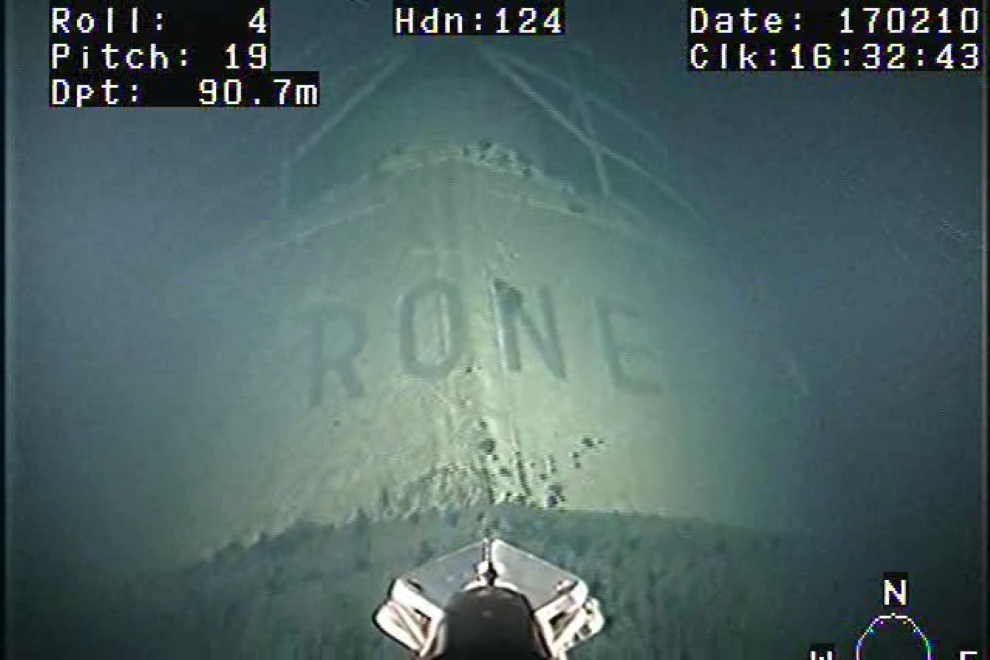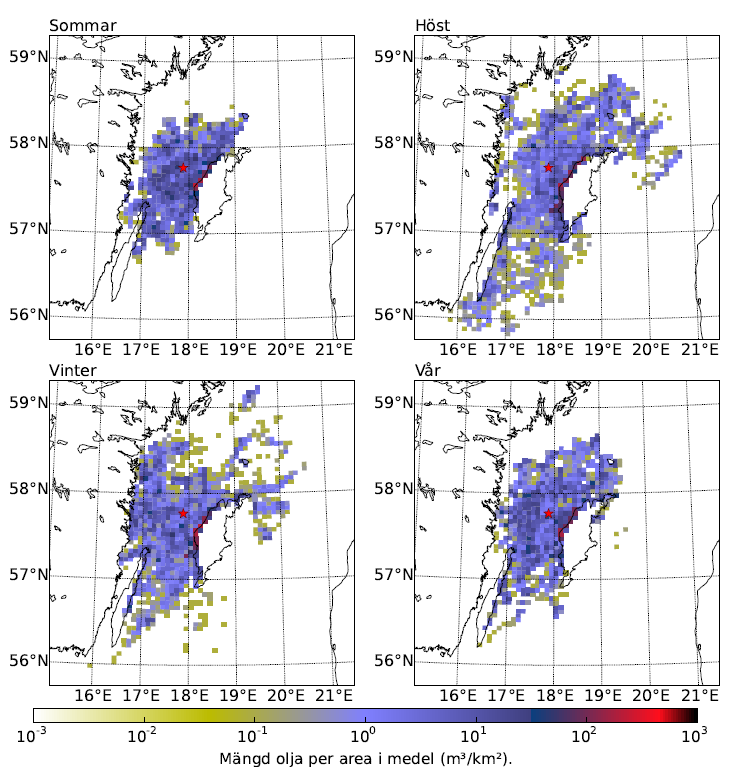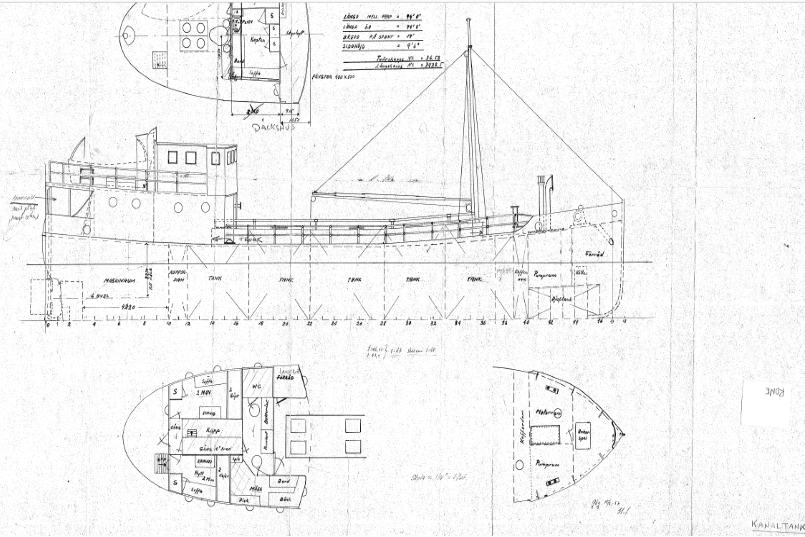Rone
During 2022, the Swedish Agency for Marine and Water Management, SwAM, led the oil recovery operation on the polluting shipwreck Rone. In total, approx. 70,000 liters of oil and oil mixed with water were removed from the wreck.

Oil being pumped from the shipwreck Rone.
The wreckage
On 19 February 1981, Rone was en route between Nynäshamn and the island of Gotland. The wind at the time was northeast, 10-15 meters per second, with moderate visibility. The reason for the accident is described as water seeping into the pump room, which caused the ship to become too heavy in the bow and then sank. At the time of the sinking, Rone had a cargo of 209 m3 of heavy fuel oil and approx. 0.4 m3 diesel for propulsion. There is no information about oil leaks during the sinking or from the years after the accident.
During an inspection by a ROV (Remotely Operated Vehicle) in 2017 the wreck was found to be in good condition. There was not much corrosion on the wreck and paint still remained on the hull. There were also no visible holes or cracks that could be detected during the inspection.
The wreck lies today at a depth of 98 meters, about 15 nautical miles west of Visby.

Photo of the stern on Rone where the vessel's name is clearly visible. Photo via ROV by the Swedish Maritime Administration.
Polluting shipwreck
The shipwreck of the vessel Rone was included in the Swedish Maritime Administration's list over the 30 most acutely hazardous wrecks in Swedish waters / Swedish economic zone. An environmental risk assessment was carried out of the approx. 30 wrecks using the probabilistic risk assessment tool Vraka (Swedish).
The environmental risk assessment showed that Rone received a risk value of 32, placing it in fifth place on the list. The information available about the wreck gave no indication that large parts of the oil had leaked into the sea.
Nature conservation area
Simulations of oil spill from the wreck over different seasons have been carried out by SMHI, where oil spill start dates have varied over six years to cover all types of wind and weather conditions. The outcome from the simulations showed that the oil, in a worst-case scenario, i.e. an uncontrolled instantaneous release of oil from the wreck, would in most cases, result in the oil affecting shores on western Gotland.

The image shows the results of simulations where an oil spill from Rone would most likely end up.
The entire Gotland coast is classified as a nature conservation area and of national interest for outdoor life. In addition, in the north and south of Gotland important bird protection areas are located, in the north; Salvorev and Gotska Sandön and in the south; Stora and Lilla Karlsö and Hoburgs bank. Tourism is also a major source of income for people on the island, which would be affected by an oil spill.
Investigation and salvage operation
In the fall of 2022, SwAM's framework contract supplier JD-Contractor began working on a detailed investigation and oil recovery operation from the Rone wreck. The technically complicated operation was carried out using ROV and a remote-controlled robotic drill. The project got off well; they drilled into the first tank and started a routine for pumping up the oil to the work vessel. This included attaching the drilling equipment and to understand what type of pump was most suitable for pumping the oil.
The project then had to be paused for a couple of weeks, due to several problems with the underwater robot and several rounds of bad weather. Eventually, the contractor was able to complete the technically complicated task successfully. They drilled into all tanks and attached the equipment to investigate whether they contained oil, except for two tanks, which were found to have cracks and were empty. In total, 13,000 liters of pure oil and 57,000 liters of oil mixed with water (a total of 70,000 liters) could be pumped up from the wreck.
Remaining amounts of oil have unfortunately leaked into the sea during the years on the seabed. The information from the marine declaration about the heavy oil (IFO 180) was that it would solidify or be very viscous already at 12 °C. This was not the case as the oil was found to be in liquid form and could be pumped to the work vessel, using a powerful pump.
The wreck did also turn out to be more degraded than what could be seen in the inspection carried out in 2017. During the work, it was found that in some places on the wreck, especially at the ventilation piping to the oil tanks, there were holes that were only covered with layers of paint. There was also an inward bend in the hull at tank pair five, which was found to have cracks, wherefrom oil likely have leaked over the years.
The result of the detailed investigation and oil recovery operation in 2022 showed that all cargo tanks were empty except one.
Cost of the operation
The detailed investigation and oil recovery operation on Rone had a cost of SEK 29,590,000. The funds come from the government's 1:4 grant for remediation and restoration of contaminated areas. SwAM's project on environmentally hazardous wrecks has, on average, removed oil for a cost of approx. SEK 150,000 per ton of salvaged oil.
This cost can be compared to the costs that the Coast Guard and municipal emergency services have during a clean-up operation after an oil spill. Even indirect costs such as lost income for the fishing industry due to smaller catches, or catches that are not allowed for sale, and from reduced tourism must be included in the calculation after an oil spill. The tourism on Gotland generated a turnover of approximately SEK 1.3 billion in 2002. The area is known for its great outdoor life and recreational fishing.
Costs for the environment, in the form of temporarily reduced natural resources and ecosystem services, are also effects after an oil spill. These effects are more difficult to estimate financially. Changes can affect important ecosystem services such as bioturbation and reduced prey availability for fish when some of the organism types (important components for benthic systems) that constitute food for fish disappear, and are replaced by species that are less valuable as food resources, as they are smaller and live deeper in the sediment.
These costs are usually higher overall compared to removing oil from a wreck as a preventive measure.
Background
Rone (prior names; Kristian, Vacuum 51, Kanaltank, Norrtank) was a diesel-powered oil tanker, built in 1916 at Kaldnes Mekaniska Verkstad A/S in Tönsberg, Norway. It was reportedly delivered in 1916 to Oslo Oljebunkring A/S.
- Length: 28.73 m, width 5.82 m, draft 3.00 m.
- Deadweight tonnage: 254 tonnes.
- Gross tonnage: 149.49 tonnes.
- Tank capacity: 250 m3 in five pairs of tanks.
- Fuel consumption per day: 1.4 m3.
At the time of wreckage, Rone had a cargo of 209 m3 heavy oil (IFO 180) and approx. 0.4 m3 diesel for propulsion. According to the protocol from the interrogation after the sea accident, the 4's tanks were empty. See below figure:
%20vraket-rone-fyrans-tankar-tomma.png)
According to the protocol from the interrogation after the sea accident, the 4's tanks were empty.
Map
Here is a map of the most environmentally dangerous wrecks in Swedish waters.
Films from Rone
You can find several films from oil recovery operations on our Youtube-account.
Photos from the investigation
Photographer senior analyst Fredrik Lindgren or JD-Contractor, which carried out the task of salvaging oil from Rone.

%20IMG_0184.JPG)
%20GITE8399.JPG)
%20IMG_0129.JPG)
%20IMG_0134.JPG)
%20IMG_0135.JPG)
%20IMG_0136.JPG)
%20IMG_0137.JPG)
%20IMG_0140.JPG)
%20IMG_0141.JPG)
%20IMG_0143.JPG)
%20IMG_0144.JPG)
%20IMG_0146.JPG)
%20IMG_0150.JPG)
%20IMG_0151.JPG)
%20IMG_0154.JPG)
%20IMG_0155.JPG)
%20IMG_0158.JPG)
%20IMG_0159.JPG)
%20IMG_0160.JPG)
%20IMG_0162.JPG)
%20IMG_0165.JPG)
%20IMG_0167.JPG)
%20IMG_0173.JPG)
%20IMG_0174.JPG)
%20IMG_0176.JPG)
%20IMG_0177.JPG)
%20IMG_0178.JPG)
%20IMG_0180.JPG)
%20IMG_0182.JPG)
%20IMG_0184.JPG)
%20IMG_0186.JPG)
%20IMG_0187.JPG)
%20IMG_0188.JPG)
%20IMG_0191.JPG)
%20IMG_0194.JPG)


